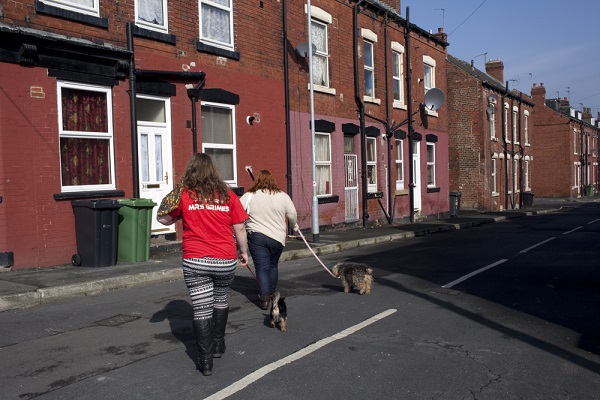2. People on Low Incomes - why is it important to act?
In 2011/12 there were an estimated 13 million people in the UK living in poverty

Credit: JRF/Liz Hingley
On this page:
Tackling poverty and inequality
There has also been a fall in real incomes – both overall1 and for those in the lowest income group. Between 2001/2 and 2011/12 there was a 5% reduction in the real incomes of households in the bottom 10% of the UK’s income distribution. Although the proportion of people reporting financial difficulties has been falling, in 2011/12 more than 10% of people in the UK still find it quite or very difficult to get by2. Considering the needs of those on low incomes is important for developing adaptation strategies which do not increase the potential for disproportionate impacts on people and communities with an already lower capability to prepare, respond and recover.
It is against this backdrop that householders are being asked to contribute more to tackling the impacts of climate change and extreme weather events. It is right that householders share some of the burden and responsibility for adaptation, but a failure to fully consider the relative capacity for households to do so is deeply divisive and inherently unjust. Where communities cannot afford to adopt measures or obtain adequate insurance, it is not possible for them to adequately prepare without outside help. If that help is not effectively provided then it is these communities which are highly likely to see some of the most extreme impacts from future flood and heatwave events. Failure to consider the needs of the most extremely vulnerable now will further erode their resilience to climate and extreme weather impacts into the future.
People on low incomes face a triple climate injustice and there is a need to consider how inequalities and the potential for greater burdens can be reduced. The development of effective adaptation strategies and related measures needs to recognise the different ways that low income groups are affected:
- They are disproportionately affected by climate change impacts such as flooding compared to higher income groups for the reasons explained in Section 1.
- They contribute least to climate change because their emissions are much lower than those of people on higher incomes. See Which households emit the most carbon?
- They are the hardest hit by the mitigation policies which raise costs of energy, therefore they are frequently living in fuel poverty. See also What can be done to tackle fuel poverty?
The need to consider equality in action features in a number of policies and frameworks associated with climate adaptation and the management of extreme weather events. However, it is vital to be able to appreciate the different challenges that are faced by low income households in order to have a sound basis to effectively deliver on these aspirations and achieve equality in outcomes.
Duties and responsibilities
Local authorities have statutory duties and responsibilities relating to people on low incomes which are relevant for action on climate impacts and extreme weather. They include:
- The Equality Act 2010 states that any authority to which the act applies “must, when making decisions of a strategic nature about how to exercise its functions, have due regard to the desirability of exercising them in a way that is designed to reduce the inequalities of outcome which result from socio-economic disadvantage.” Therefore an authority’s policy and planning systems for climate adaptation and all related duties need to consider ways in which equality in outcomes can be achieved.
- The Child Poverty Act places duties on local authorities and named partner authorities to cooperate with a view to reducing, and mitigating the effects of, child poverty in their local areas.
- The Health and Social Care Act (2012) and related Joint Strategic Needs Assessments requires the consideration of a range of factors which determine health outcomes, including factors associated with the socio-economic determinants of health.
- The Civil Contingencies Act 2004 identifies Local Authorities as one of the organisations who have a responsibility for developing plans for emergency situations.
- The Heatwave Plan for England is non-statutory but provides a basis through which other obligations to produce adaptation plans can be developed. Its main purpose is to provide information which helps in the process of building more resilient communities to heat-waves. It sets out ways to prepare for heat-wave events and what to do to avoid some of the most severe impacts from prolonged exposure to high temperatures.
- The Housing White Paper 2017. The white paper “Fixing our broken housing market” sets out a broad range of reforms that government plans to introduce to help reform the housing market and increase the supply of new homes. Providing new homes needs to be balanced with issues like development in the flood plain (see Section 3 of Which places are disadvantaged?)
References
- Randall, C, Corp A and Self, A (2014) Measuring National Well-being: Life in the UK, 2014 Office for National Statistics
- McInnes, T. et al, Monitoring Poverty and Social Exclusion 2013
- Preston, I., White, V., Thumin, J. and Bridgeman, T (2013) Distribution of carbon emissions n the UK: implications for domestic energy policy. The Joseph Rowntree Foundation, York.

Built by:

© 2014 - Climate Just
Contact us
